What have the Romans ever done for us?
So goes the line in the famous Monty Python movie "The life of Brian" but as far as Spain is concerned, the Romans actually did quite a bit for the country and much of what they built still exists today, so we picked out ten of our favourite Roman sites that you can go and see when you visit Spain.
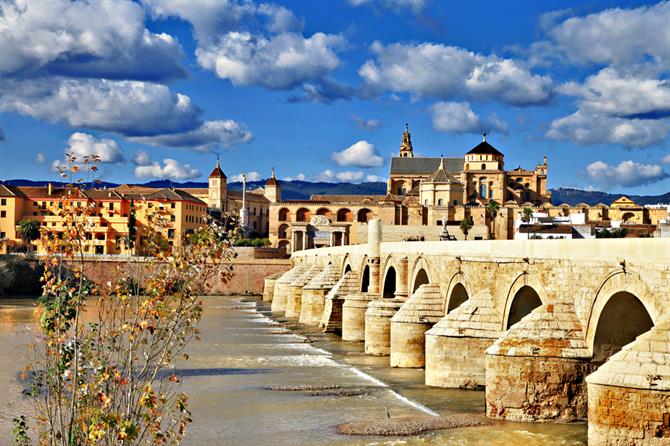
1. Cordoba
The city of Cordoba, sometimes known as Cordova, is situated in Andalusia in the south of the country and has roots in not only Roman civilisation, but also earlier, as a major city for the Iberians, and later, as a principal area of rule by the Moorish kings in the region.
In fact, peering into the depths of history, it seems everyone wanted a piece of the city and not only did Cordoba occupy a very important place in the Roman occupation, it also proved popular in the Byzantine Empire (roughly between 552 and 572) and under the Visigoths, who conquered Cordoba in the late sixth century AD.
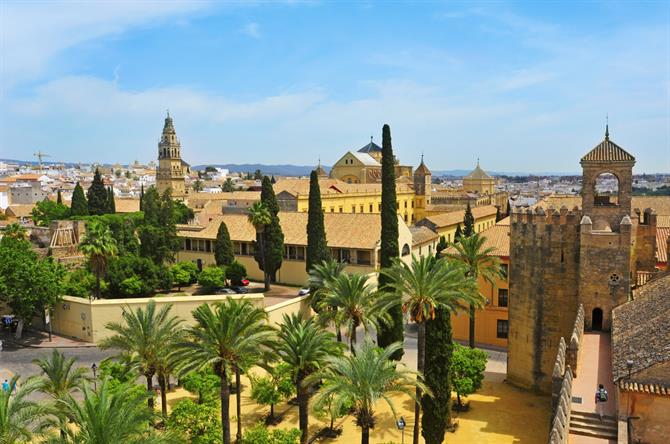
Many of the Roman temples became Mosques, or mesquitas, like the one above, and later still, many were then turned into churches and cathedrals after the Catholics regained power in Spain.
Suggested Roman sites to see in Cordoba would be the great mosque, the Roman bridge, the forum, a Roman temple, the mausoleum, the remaining sections of the city walls, and also the various churches, often built slap bang on top of Roman temples. The city centre is a world heritage site and well worth a visit.
2. Valencia
Often overlooked in terms of Roman history, nevertheless, Valencia was founded as a small community off the Turia river in 138 BC and was known as Valentia. The occupation may have largely being strategic as in these times, the port to the north of the city known as Sagunto, was far more important in terms of trade and wealth, something we will touch upon a bit later in the article.
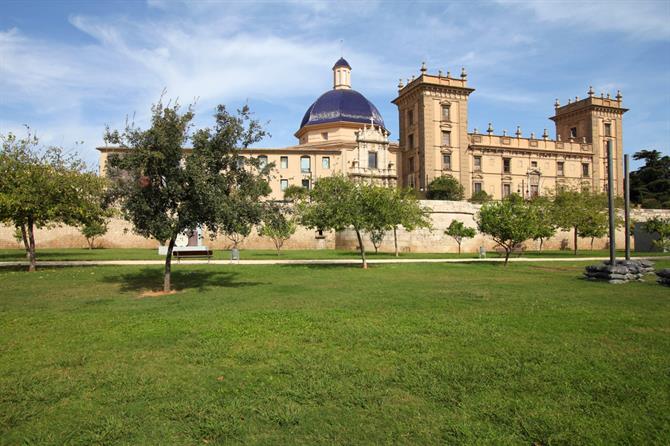
So where can you find Roman ruins in Valencia to go and have a look at?
Well, the city has over 40 museums, but the one to head for would presumably be the Roman Museum, which is located at Plaza de la Almoina, near to the cathedral. However you don't need to even go into a museum, simply find yourself at Colon tube stop and you will see the remains of a Roman road inside and underground, plus more remains when you exit the tube. To be honest, there are probably loads of remains of Roman occupation waiting to be discovered in the city.
3. Lliria, the capital of the Camp De Turia.
The ancient town of Lliria was founded in Pre-Roman times by the Iberians, on top of a defensive hill, and was known as Edeta, however the Romans conquered the area and moved the town further down the hill, and much of their legacy remains today. If you want to see Roman remains around Valencia, this is the place to come, and on Saturdays, the tourist office do guided tours, sometimes commentary is offered in passable English.

Being at the centre of Roman life in the area has brought opportunities and problems for the city. Whenever a new building is being made and the foundations are dug, lo and behold, Roman remains are found.
It can be something as mundane as Roman sewers, to the scattered foundations of old houses, however the town does, in my opinion, not exploit it's rich legacy enough, with many property developers quickly covering newly discovered remains as to not halt the construction of their precious buildings.
Despite Spain having built far too many houses in recent years, and many lying idle and empty across the region, in their infinite wisdom, the town approved the construction of a new housing estate. Excavations there allegedly revealed a tunnel leading to catacombs from the Muslim age, containing 125 skeletons, all buried pointing towards Mecca.
They also, I was told, found Roman bread ovens and various other artefacts at the site. This was quickly covered over and the building work continued. This information is an exclusive to Spain Holiday and has never been released into the public domain until now.
Here is a promotional video (in Spanish) all about Lliria.
The largest hoard of gold ever to be found in Spain was also in Lliria, and is now in a museum in Madrid, along with a large Roman mosaic known as the 12 pillars of Hercules, found about 80 years ago, in a back garden of a house at the end of my street. Again, no signs or information boards are ever put up indicating this.
There are areas of the town such as Calle Alcublas, and also Calle La Venta, where Roman and slightly later stones, parts of arches, pillars and columns are just lying strewn across waste ground with no-one seemingly bothered to collect them up and do something with them. There is also the "Pla De L'arc" on the main road heading eastwards, which is the bottom half of a large Roman arch and gateway to the old town.
In the main shopping street, you will find this doorway. Go through it!
This leads us to the two other suggested sites, namely the Roman Mausoleum from the 1st century, the "city of the dead", which in the 1st century would have been located on a road, outside the old Roman walls. The square stone with the hole in the foreground would be where burial urns containing ashes were placed. The relatives of the deceased would come here on special occasions and have a sort of picnic on the stone, to offer these things up to the gods, and for protection in the afterlife.
Another Roman ruin in Lliria that must definitely be visited is the Roman Leisure centre, one of the most important Roman sites in the region. Once again, due to the recession, renovation work has been put on hold until the money comes back in but it covers quite a large area and one will find mosaics, Roman baths and other curiosities.
4. Sagunto.
Staying briefly in the Valencia reign, the port of Sagunto was for many years, a far more important place than the city of Valencia, and has a wealth of intact Roman sites to explore, in fact the good condition of some of them often takes the first time visitor by surprise.
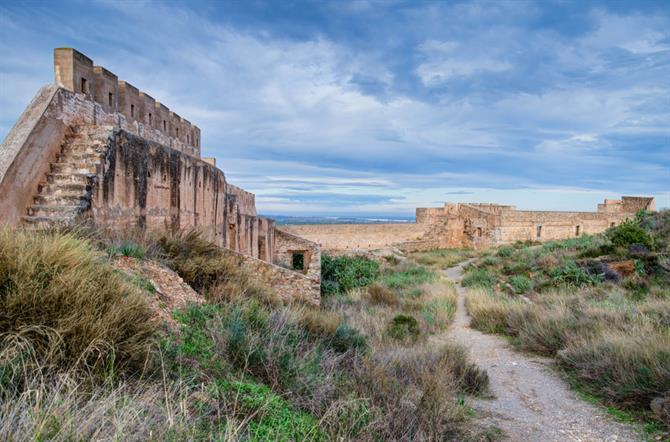
The town boasts an impressive 1st century theatre, remains of Roman bridges and other quayside structures, plus the remains of a Roman temple dedicated to Diana, who I am told was the Roman goddess of hunting, also of the moon and was long associated with wild animals and woodland, having the power to talk to and control animals.
There are also many Jewish and Moorish remains to see too, and if you get tired with walking around in this heat, simply head a couple of miles towards the sea where much of the Roman past can be found at the port, and of course the beach is next door, so high time for a swim in the inviting Mediterranean waters!
5. Segovia
The ancient city of Segovia lies to the west of Madrid, and was originally populated by the celts. The city lies in an elevated position and as such gets a lot colder than most areas during winter time, and has an above average amount of rainfall compared to it's nearby neighbours.
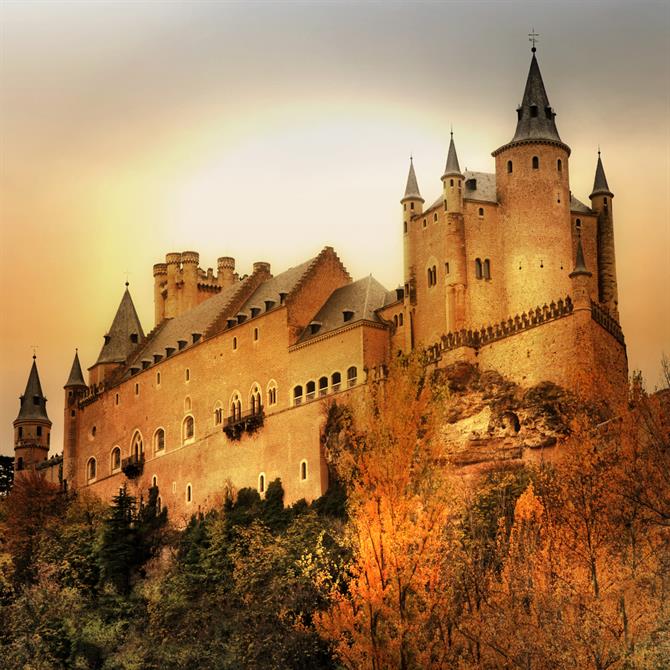
The city is, as you would expect, awash with artefacts and remains from diverse time periods, and upon arriving in the city, one of the first things that the visitor absolutely cannot miss without actually shutting their eyes, is the awe inspiring Roman aqueduct that spans the upper part of the town and is still in use today.
The bridge carries water from the Fuente fria (Cold spring) river, via water deposits which were cleverly designed by the Romans to filter out sand and impurities, before arriving in the city as drinking water. It is believed to have been built in the 1st century.

Apart from the impressive Aqueduct, the visitor to Segovia can see the Alcazar or Royal Palace (Previous photo) which sits proudly on a rocky outcrop, guarding the town and it''s inhabitants, plus the cathedral is a must see too, as are the old city walls, the Jewish quarter, the Roman Mausoleum and the multitude of parks and museums within the city. It's not a place that one could be bored, not for very long anyway.
6. Lugo.
The city is located in Galicia, the windswept Northwest corner of Spain and for the first time visitor, a very different part of Spain, in both history, climate and culture, not to mention the bad weather from the Atlantic too! It is an important stopping place on the famous Camino de Santiago pilgrimage route.
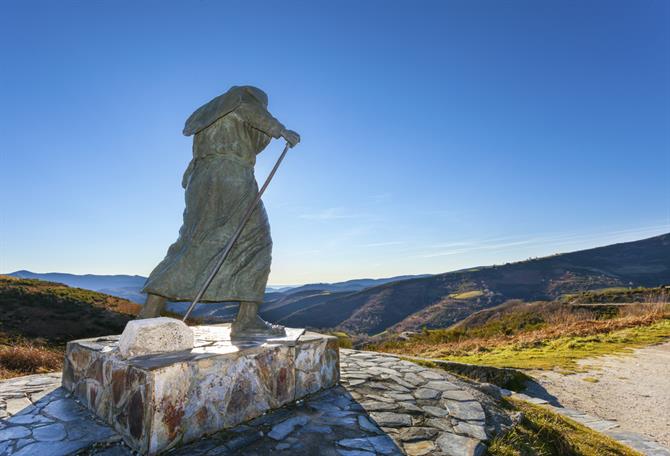
There exists a lovely Roman bridge over the gushing and surprisingly cold Minho river, and also various other relics of Roman occupation, although the Celtic roots are more evident than other remains found in cities further south. It is not just an old fashioned city though and has various modern shopping centres such as Abella and As Termas, and hosts many important regional government departments and offices.
Lugo is also the only European city to be completely surrounded by intact Roman walls, sections of which can be walked along and this should be your first port of call upon arrival and it is a good way to see how the city has evolved over time.
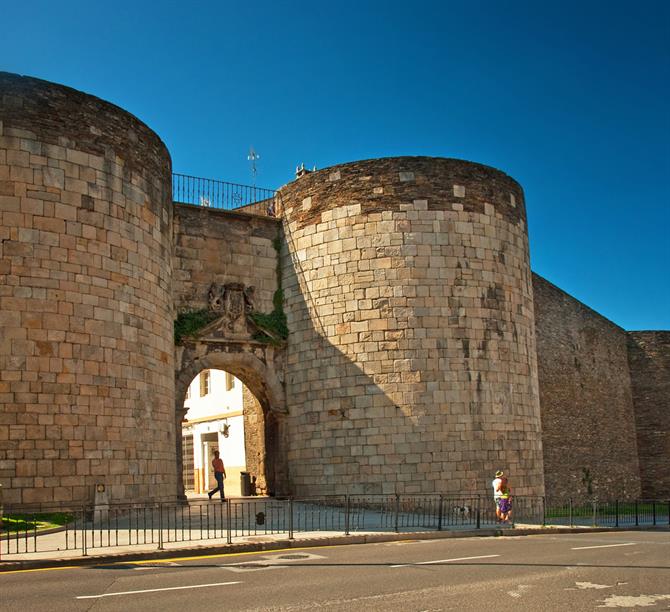
Lugo is certainly somewhere well worth a visit and perhaps a gateway to staying somewhere around the Galicia region this year for your Spanish holiday?
7. Tarragona
The city of Tarragona is where we next meet and although the city was important in Roman times, it also gives it's name to the entire region. The province itself lies in Catalonia, so expect to hear Catalan spoken more widely than Castillan Spanish. The coastline of the Costa Dorada is here too and has loads of sandy beaches and historical towns to explore.
The Roman influence is highly visible in the area, with some fantastically preserved and very interesting places to go and see, evoking the golden era of Roman Spain with amphitheatres, temples and arena still there today, like the one below.
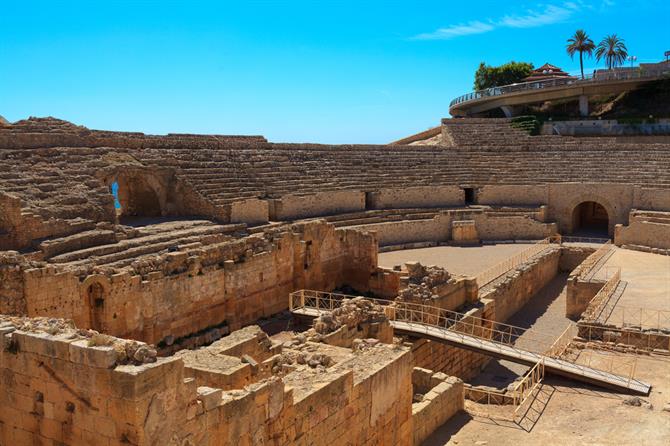
The area is, to be honest, more famous for it's modern day facilities such as theme parks and beach resorts, and with easy travel from the UK to either Barcelona, Reus or Girona airports, it's very accessible from the UK, in fact why not please everyone in your party, by promising to treat them to a day at the Port aventura theme park, as long as they plod around with you and look at Roman remains the next day?
8. Barcelona
When searching for Roman remains, the Catalan capital of Barcelona began life as a settlement established by Roman Emperor Augustus between 15-10 BC. Much of what exists from the Roman era is largely ensconced in various areas of the city, shoe horned between modern buildings, or down the back of some obscure alleyway, nevertheless it's a voyage of discovery for sure.
Much of what remains in the city can be found in the Gothic quarter (below), known as the Barrio Gòtico.
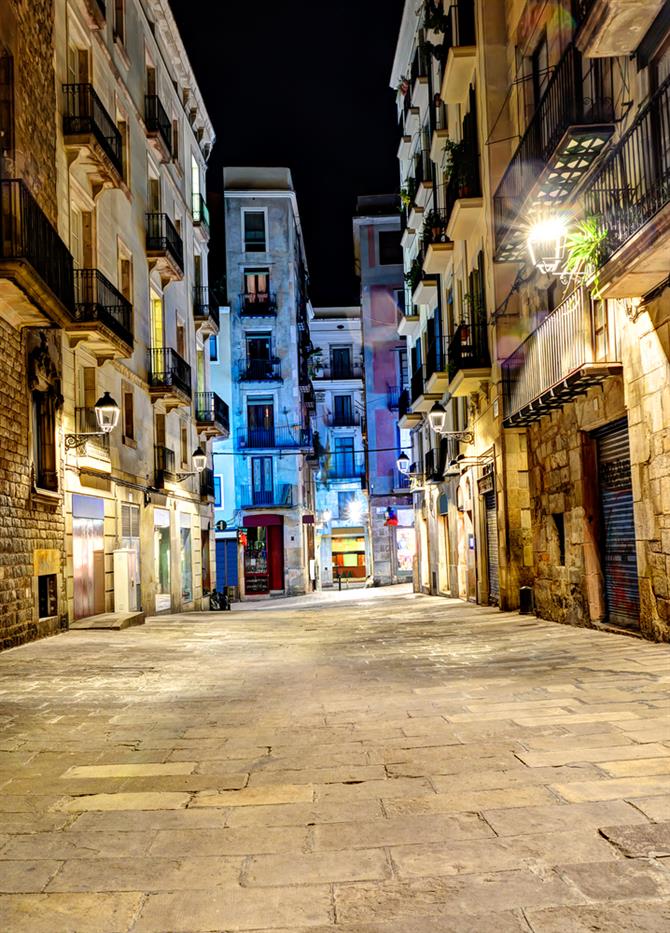
The temple of Augustus, or at least what's left of it, is a must see for Roman spotters, and it consists of a courtyard within the Centre Excursionista de Catalunya (Plaça Sant Jaume, near to Carrer del Paradís), containing four very impressive 9 metre tall columns, left over from a temple built in around 1 BC.
If you find yourself at the Las Ramblas area of the city, and chances are if you are tourist then that is a foregone conclusion, then quite weirdly, sandwiched between some cafes and a few small boutique stores, one may find the remains of a Roman necropolis from around the 2nd century. This can be found around the Plaça Villa de Madrid which is easy to find.
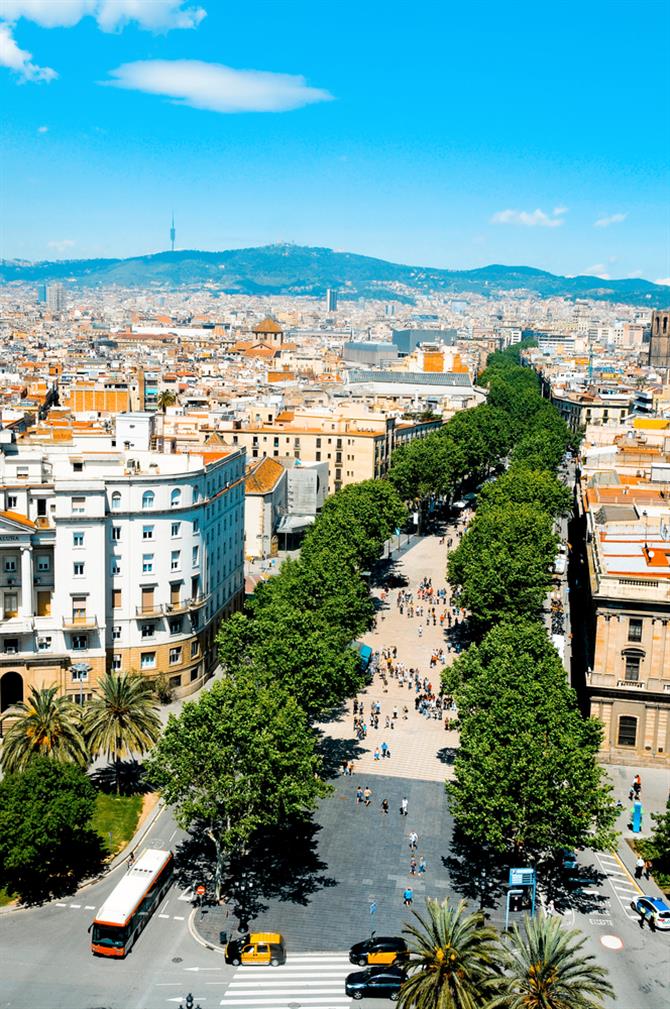
Other Roman spots to see in the city should include the Museu d'Història de la Ciutat de Barcelona, which is actually built over extensive Roman remains, and also check out Plaça Ramon Berenguer, a section of the old city walls, along with Gothic chapel of Santa Àgata.
9. Toledo
The city became a Roman stronghold and important strategic town about 192 BC and was captured from the Celtic-Iberian people. Some pretty impressive engineering went on during the Roman period, especially where water was concerned and remains can be seen today of an Ancient dam and various water channels and clever bits of engineering. Archaeologists discovered three separate water distribution systems were in place serving the city.
We can find remains of 2 aqueducts, and a quirky bit of early engineering in the form of the Torre del Horno del Vidrio which was invented to enable the water to lose height via a cylindrical shaft, feeding the water into the city systems. There is also a mysterious cave beneath a church in the Callejon de San Ginès, known as La cueva de Hercules, plus the city boasts various remains of Roman bridges, Roman Baths at the Plaza de Amador de los Rios and vaults at the Calle Nuncio Viejo.

One can also find the remains of a huge Roman circus, however the sights of Toledo do not stop there, and a walk around the city reveals monuments, gates, churches, mosques, synagogues, from the past two millennia and reflecting the turbulent history and population changes of the city. Toledo is definitely a place to spend some time in.
10. Merrida
The city of Merrida is located in the region of Extramadura and contains a massive array of well preserved Roman remains, notably the extremely impressive theatre, still complete with colonnaded backdrop, seating and stage areas.
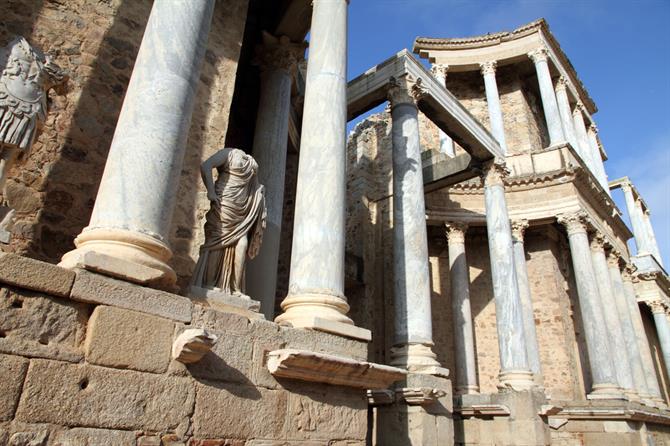
Also make sure to see the huge remains of the old aqueduct, and the Roman Circus, one of the largest ruins of the Roman era in the country, and which was a chariot racing track, so huge, the arena seated up to 30,000 people!
In fact Merrida would be, in my opinion, the place to visit if it is Roman remains you seek because this place houses what must be the largest collection of preserved remains anywhere in the country.

As you can see from our definite top ten list of the best Roman sites in Spain, the country never fails to please even the most fussy of traveller, and just standing amongst the ruins of an old palace or theatre, you can feel these ancient times all around you. What must life have been like during the reign of the Romans?
Spain has far more places of Roman interest than just this list, and further research is invited, to discover places such as Cartagena, Tarifa, Cadiz, and so on.
Well, now you have this list, all that remains is to book your holiday to Spain and come and see some of them for yourself. Thanks for reading this, I really hope you enjoyed my research and I hope that you will one day see some of these places for real.
